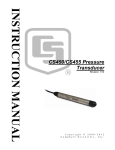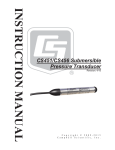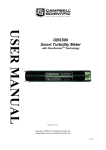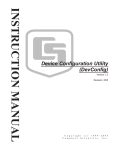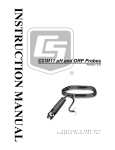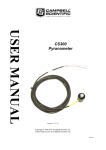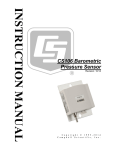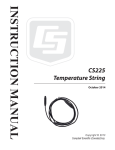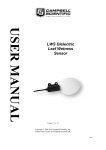Download Campbell CS451 Product manual
Transcript
CS451/CS456 Submersible Pressure Transducer Revision: 1/13 C o p y r i g h t © 2 0 0 9 - 2 0 1 3 C a m p b e l l S c i e n t i f i c , I n c . Warranty “PRODUCTS MANUFACTURED BY CAMPBELL SCIENTIFIC, INC. are warranted by Campbell Scientific, Inc. (“Campbell”) to be free from defects in materials and workmanship under normal use and service for twelve (12) months from date of shipment unless otherwise specified in the corresponding Campbell pricelist or product manual. Products not manufactured, but that are re-sold by Campbell, are warranted only to the limits extended by the original manufacturer. Batteries, fine-wire thermocouples, desiccant, and other consumables have no warranty. Campbell’s obligation under this warranty is limited to repairing or replacing (at Campbell’s option) defective products, which shall be the sole and exclusive remedy under this warranty. The customer shall assume all costs of removing, reinstalling, and shipping defective products to Campbell. Campbell will return such products by surface carrier prepaid within the continental United States of America. To all other locations, Campbell will return such products best way CIP (Port of Entry) INCOTERM® 2010, prepaid. This warranty shall not apply to any products which have been subjected to modification, misuse, neglect, improper service, accidents of nature, or shipping damage. This warranty is in lieu of all other warranties, expressed or implied. The warranty for installation services performed by Campbell such as programming to customer specifications, electrical connections to products manufactured by Campbell, and product specific training, is part of Campbell’s product warranty. CAMPBELL EXPRESSLY DISCLAIMS AND EXCLUDES ANY IMPLIED WARRANTIES OF MERCHANTABILITY OR FITNESS FOR A PARTICULAR PURPOSE. Campbell is not liable for any special, indirect, incidental, and/or consequential damages.” Assistance Products may not be returned without prior authorization. The following contact information is for US and international customers residing in countries served by Campbell Scientific, Inc. directly. Affiliate companies handle repairs for customers within their territories. Please visit www.campbellsci.com to determine which Campbell Scientific company serves your country. To obtain a Returned Materials Authorization (RMA), contact CAMPBELL SCIENTIFIC, INC., phone (435) 227-9000. After an applications engineer determines the nature of the problem, an RMA number will be issued. Please write this number clearly on the outside of the shipping container. Campbell Scientific’s shipping address is: CAMPBELL SCIENTIFIC, INC. RMA#_____ 815 West 1800 North Logan, Utah 84321-1784 For all returns, the customer must fill out a “Statement of Product Cleanliness and Decontamination” form and comply with the requirements specified in it. The form is available from our web site at www.campbellsci.com/repair. A completed form must be either emailed to [email protected] or faxed to (435) 227-9106. Campbell Scientific is unable to process any returns until we receive this form. If the form is not received within three days of product receipt or is incomplete, the product will be returned to the customer at the customer’s expense. Campbell Scientific reserves the right to refuse service on products that were exposed to contaminants that may cause health or safety concerns for our employees. Table of Contents PDF viewers: These page numbers refer to the printed version of this document. Use the PDF reader bookmarks tab for links to specific sections. 1. Introduction .................................................................1 2. Cautionary Statements...............................................1 3. Initial Inspection .........................................................1 4. Quickstart ....................................................................2 4.1 4.2 4.3 4.4 4.5 4.6 Step 1 — Desiccant Check...................................................................2 Step 2 — Choose Appropriate Depth...................................................2 Step 3 — Dislodge Bubbles .................................................................3 Step 4 — Install Transducer.................................................................3 Step 5 — Measure Initial Water Elevation...........................................3 Step 6 — Use SCWin to Program Datalogger and Generate Wiring Diagram................................................................................4 5. Overview......................................................................6 6. Specifications .............................................................8 7. Operation ...................................................................10 7.1 Configuration .....................................................................................10 7.1.1 PC Connection Using the A200 ..................................................10 7.1.1.1 Driver Installation ............................................................10 7.1.1.2 Wiring ..............................................................................10 7.1.1.3 Powering the Sensor.........................................................11 7.1.1.4 Determining which COM Port the A200 has been Assigned .......................................................................11 7.1.2 Device Configuration Utility (version 2.03 or higher)................12 7.1.3 SDI-12 Transparent Mode ..........................................................12 7.1.4 RS-232 Connection via PC Terminal Software ..........................14 7.1.5 SDI-12 Commands......................................................................15 7.1.5.1 SDI-12 Addresses.............................................................16 7.1.5.2 Extended SDI-12 Commands ...........................................17 7.2 Installation Considerations.................................................................18 7.2.1 Non-Vertical Installations ...........................................................18 7.2.2 Offset Calculation .......................................................................18 7.2.3 Split Mesh Cable Grip (pn 25431) ..............................................19 7.3 Wiring ................................................................................................19 7.3.1 SDI-12.........................................................................................20 7.3.2 RS-232 ........................................................................................20 i Table of Contents 7.4 Programming ..................................................................................... 20 7.4.1 CRBasic Programming............................................................... 21 7.4.1.1 Example Program for CR200(X)-Series Datalogger ....... 21 7.4.1.2 Example Program for CR1000 Datalogger..................... 22 7.4.2 Edlog Programming ................................................................... 22 7.4.2.1 Example Program for CR10(X) Dataloggers................... 23 8. Maintenance ..............................................................23 8.1 8.2 Every Visit......................................................................................... 24 Every Two to Three Years or on a Rotating Schedule ...................... 24 9. Troubleshooting........................................................24 Appendix A. Calibration Certificate.............................................A-1 Figures 5-1. 7-1. 7-2. 7-3. 7-4. 7-5. CS451 nose cone options..................................................................... 7 A200 Sensor-to-PC Interface............................................................. 11 Connect screen .................................................................................. 12 Terminal Emulator ............................................................................ 13 Terminal Emulator ............................................................................ 15 Transducer suspended with split mesh cable grip ............................. 19 7-1. 7-2. 7-3. 7-4. 7-5. 7-6. 7-7. Factory Settings................................................................................. 10 A200 Wiring...................................................................................... 11 RS-232 Settings................................................................................. 14 RS-232 Terminal Commands ............................................................ 15 SDI-12 Commands ............................................................................ 16 SDI-12 Wiring................................................................................... 20 RS-232 Wiring .................................................................................. 20 Tables ii CS451/CS456 Submersible Pressure Transducer 1. Introduction The CS451/CS456 Submersible Pressure Transducer provides pressure and temperature measurements. It uses the SDI-12 or RS-232 communications protocols to communicate with an SDI-12 or RS-232 recorder simplifying installation and programming. The -L in the transducer’s model name indicates user-specified cable length. Before using the CS451/CS456 please study • • • 2. 3. Section 2, Cautionary Statements Section 3, Initial Inspection Section 4, Quickstart Cautionary Statements • Sensor will be damaged if it is encased in frozen liquid. • Although the CS451/CS456 is rugged, it is also a highly precise scientific instrument and should be handled as such. There are no user-serviceable parts and any attempt to disassemble the device will void the warranty. • Care should be taken when opening the package not to damage or cut the cable jacket. • Dropping the instrument or allowing it to “free fall” down a well may damage the transducer. • Never suspend the CS451/CS456 from the connections at the top end of the cable. Sharp bends or excessive pinching of the cable can cause damage and may pinch off the vent tube causing measurement errors. • Confirm the compatibility of the sensor and cable to non-water environments before installation. • The CS456 should be used in harsh water applications, including salt water. Initial Inspection • Upon receipt of the CS451/CS456, inspect the packaging for any signs of shipping damage and, if found, report the damage to the carrier in accordance with policy. The contents of the package should also be inspected and a claim filed if any shipping related damage is discovered. 1 CS451/CS456 Submersible Pressure Transducer 4. • The model number and pressure range is etched on the housing and the cable length is printed on the label near the connection end of the cable. Check this information against the shipping documentation to ensure that the expected product was received. • The transducer comes with a desiccant tube attached to the cable. Quickstart This quickstart guide assumes: • • Default settings used (SDI-12 address 0, pressure reported in psig, temperature reported in C) ShortCut Program Generator for Windows (SCWin) used to program datalogger, calculate offset, and generate wiring diagram For complete configuration, installation, wiring, and programming information, see Section 7, Operation. 4.1 Step 1 — Desiccant Check CAUTION The desiccant tube is shipped with a black cap to cover the vent hole. This cap MUST be removed prior to installation. Ensure the desiccant is blue; replace if not. The desiccant tube must always be attached to the CS451/CS456. 4.2 Step 2 — Choose Appropriate Depth The CS451/CS456 must be installed below the water at a fixed depth. This depth should be chosen so the water pressure will never exceed the transducer’s pressure range (twice its pressure range). CAUTION The output reading will not be correct, and the transducer can be damaged if pressure is excessive (2 x full scale). Pressure can be converted to feet of fresh water using the following simple equation: 1 psi = 2.31 feet of water For example, the maximum depth with a pressure range of 0 to 7.25 psig is 16.748 feet of water. 2 CS451/CS456 Submersible Pressure Transducer 4.3 Step 3 — Dislodge Bubbles While submersing the transducer, air bubbles may become trapped between the pressure plate and the water surface, causing small offset errors until the bubbles dissolve. Dislodge these bubbles by gently shaking the CS451/CS456 while under water. 4.4 CAUTION If bubbles are not removed by rotation and shaking underwater (or bleeding out the air in a closed system), the CS451/CS456 reading will drift lower by the distance of the gap as the bubbles are slowly dissolved into the water over time. CAUTION Hitting against the well casing or other solid surface could damage the transducer. Step 4 — Install Transducer Lower the transducer to an appropriate depth. CAUTION Do not drop the instrument or allow it to “free fall” down a well as this may damage the sensor. With long drops it may be necessary to use the weighted nose cone (option -WN). The transducer body can be strapped with tie wraps or tape. Campbell Scientific offers cable ties (pn 7421) that can be used to secure and strain relief the cable. If installing in a well, fasten the cable to the well head. Wrap the cable ties around the cable jacket. CAUTION Never suspend the CS451/CS456 from the connections at the top of the cable. Sharp bends or excessive pinching of the cable can cause damage and may pinch off the vent tube causing measurement errors. Several readings should be taken to ensure proper operations after installation. 4.5 Step 5 — Measure Initial Water Elevation Use a staff gauge (or other device) to measure the initial elevation of water. This value is used to calculate an offset that corrects the final measurement for errors due to zero offset or installation. SCWin will make the offset calculation. Refer to Section 7.2.2, Offset Calculation, if not using SCWin to calculate the offset. 3 CS451/CS456 Submersible Pressure Transducer 4.6 Step 6 — Use SCWin to Program Datalogger and Generate Wiring Diagram The simplest method for programming the datalogger to measure a CS451/CS456 is to use SCWin. 4 1. Open Short Cut and click on New Program then select Next. 2. Select a datalogger and scan interval then select Next. CS451/CS456 Submersible Pressure Transducer 3. Select CS451/CS456 Pressure Sensor, click the right arrow to add it to the list of sensors to be measured, then select Next. 4. Select Offset Calculation then select lvl_ft for the Linked Level and enter the initial water level in the Observed Level Reading box. Enter initial water elevation here 5. Choose the outputs and then select Finish. 6. In the Save As window, enter an appropriate file name and select Save. 7. In the Confirm window, click Yes to download the program to the datalogger. 5 CS451/CS456 Submersible Pressure Transducer 8. NOTE 5. Click on Wiring Diagram and wire according to the wiring diagram generated by SCWin Short Cut. Refer to Section 7, Operation, for wiring, offset calculation, and programming information if not using SCWin Short Cut. Overview The CS451/CS456 Submersible Pressure Transducer is designed to provide a reliable, accurate pressure/level measurement that is fully temperature compensated. The 24 bit A/D has simultaneous 50/60 Hz rejection and automatic calibration for each measurement. A number of additional advanced measurement techniques are employed to harness the best possible performance available from today’s state-of-the-art pressure transducer technology. The transducer reverts to a low power sleep state between measurements. A series of measurements are performed yielding a temperature and pressure value. This measurement cycle takes less than 1.5 second. The transducer can also be configured to output pressure only in less than 1 second. The measurement cycle is activated by commands via SDI-12 or RS-232 terminal commands. The design uses a piezoresistive sensor housed in a 316L stainless-steel (CS451) or titanium (CS456) package to enhance reliability. The rugged construction makes the CS451/CS456 suitable for water level measurement in irrigation applications, water wells, lakes, streams and tanks. The titanium package of the CS456 makes it ideal for salt water or other harsh environments. The cable incorporates a vent tube to compensate for atmospheric pressure fluctuations and the jacket is made of rugged Hytrel®, designed to remain flexible and tough, even under harsh environmental conditions. 6 CS451/CS456 Submersible Pressure Transducer The CS451/CS456 has two communication options: SDI-12 or RS-232. The CS451/CS456 is shipped from the factory with both communications options enabled; there is no configuration required. As an SDI-12 sensor, the CS451/CS456 is shipped with an address of 0. Two values are output by the CS451/CS456—pressure/level and temperature. The CS451/CS456 is shipped from the factory to output pressure in psig and temperature in degrees Celsius. The CS451/CS456 has three nose cone options. FIGURE 5-1 shows the nose cone options. The weighted nose cone makes the transducer easier to submerge to depth. The NPT nose cone allows the transducer to be used in closed-pipe applications. The nose cones can be switched out later. Standard Nose Cone Weighted Nose Cone NPT Nose Cone FIGURE 5-1. CS451 nose cone options 7 CS451/CS456 Submersible Pressure Transducer 6. Specifications Features: • Output acceptable for recording devices with SDI-12 or RS-232 capability including Campbell Scientific dataloggers • Quality construction that ensures product reliability • Rugged stainless steel or titanium case that protects piezoresistive sensor • Fully temperature compensated • Low power sleep state between measurements that reduces power consumption • Weighted nose cone offered that adds 0.2 kg (7.4 oz) to the transducer’s weight. Additional weight makes submersion of the transducer easier Compatible Dataloggers: CR200(X) series CR800 CR850 CR1000 CR3000 CR5000 CR500 CR510 CR10(X) CR23X Power Requirements: 5 to 18 Vdc Power Consumption: Quiescent current < 50 µA Measurement/Communication Current: 8 mA for 1-s measurement Maximum Peak Current: 40 mA Measurement Time: Less than 1.5 s Outputs: SDI-12 (version 1.3) 1200 bps RS-232 9600 bps Measurement Ranges: 8 Pressure (psig) Pressure (kPa) Depth of fresh water 0 to 2.9 0 to 20 0 to 2 m (6.7 ft) 0 to 7.25 0 to 50 0 to 5.1 m (16.7 ft) 0 to 14.5 0 to 100 0 to 10.2 m (33.4 ft) 0 to 29 0 to 200 0 to 20.4 m (67 ft) 0 to 72.5 0 to 500 0 to 50.9 m (167 ft) 0 to 145 0 to 1000 0 to 102 m (334.5 ft) Accuracy: ±0.1% full scale range TEB* or ±0.05% full scale range TEB** Resolution: 0.0035% full scale range CS451/CS456 Submersible Pressure Transducer CAUTION Overpressure: 2x pressure range Dry Storage Temperature: ─10° to 80°C Sensor will be damaged if it is encased in frozen liquid. Operating Temperature: 0° to 60°C Temperature Accuracy: ±0.2°C Maximum Cable Length: SDI-12 (one transducer connected to a single port): ~475 m (1500 ft) SDI-12 (10 transducers connected to a single port): 60 m (200 ft) RS-232: 60 m (200 ft) Cable Type: 5 Conductor, 26 AWG Hytrel Jacket Body Material: CS451 – 316L Stainless Steel CS456 – Titanium Element Material: CS451 – 316L Stainless Steel CS456 – Hastelloy Top Cone Material: Delrin Dimensions: Length 213.36 mm (6.875 in) Diameter 21.34 mm (0.84 in) Distance from pressure sensor interface (black line etched on housing) to: End of NPT fitting: 2.54 cm (1 in) End of standard nose cone: 2.3 cm (0.9 in) End of weighted nose cone: 9.9 cm (3.9 in) Air Gap Standard and weighted nose cone: NPT fitting: Weight: 25431 Split Mesh Grip Accepts cable diameter: Breaking Strength: 0.653 cm (0.257 in) 2.72 cm (1.07 in) CS451: 0.17 kg (0.37 lb) CS456: 0.10 kg (0.23 lb) Cable: 0.421 kg/m (0.283 lb/ft) 4.57 to 6.35 mm (0.18 to 0.25 in) ~300 lb * Total Error Band (TEB) includes the combined errors due to nonlinearity, hysteresis, nonrepeatability, and thermal effects over the compensated temperature range, per ISA S51.1. ** 0.05% full scale range accuracy not available in the 0 to 2.9 psig range. 9 CS451/CS456 Submersible Pressure Transducer 7. Operation 7.1 Configuration The CS451/CS456 is configured at the factory with default settings: TABLE 7-1. Factory Settings SDI-12 Address 0 RS-232 Baud Rate 9600 Pressure/Level Units PSIG Temperature Units Celsius Communicating with the CS451/CS456 requires the sensor to be either connected to a PC or to an SDI-12 recorder. The sensor typically connects to a PC via the A200 sensor to PC interface. Many SDI-12 recorders allow communication to the sensor via a terminal screen. Configurable settings can be changed via SDI-12 commands or by using Campbell Scientific’s software Device Configuration Utility. 7.1.1 PC Connection Using the A200 The A200 or another device is required to connect the CS451/CS456 to a PC. This allows sensor settings to be changed via our Device Configuration Utility. 7.1.1.1 Driver Installation If the A200 has not been previously plugged into your PC and your PC operating system is not Windows 7, the A200 driver needs to be loaded onto your PC. NOTE Drivers should be loaded before plugging the A200 into the PC. The A200 drivers can be downloaded, at no charge, from: www.campbellsci.com/downloads. 7.1.1.2 Wiring One end of the A200 has a terminal block while the other end has a type B female USB port. The terminal block provides 12V, G, TX, and RX terminals for connecting the sensor (see FIGURE 7-1 and TABLE 7-2). A data cable (pn 17648) ships with the A200. This cable has a USB type-A male connector that attaches to a PC’s USB port, and a type B male connector that attaches to the A200’s USB port. 10 CS451/CS456 Submersible Pressure Transducer 7.1.1.3 Powering the Sensor The A200 provides power to the sensor when it is connected to a PC’s USB port. An internal DC/DC converter boosts the 5 Vdc supply from the USB connection to a 12 Vdc output is required to power the sensor. 7.1.1.4 Determining which COM Port the A200 has been Assigned When the A200 driver is loaded, the A200 is assigned a COM port number. This COM port number is needed when using the Device Configuration Utility or a PC terminal software such as HyperTerminal. Often, the assigned COM port will be the next port number that is free. However, if other devices have been installed in the past (some of which may no longer be plugged in), the A200 may be assigned a higher COM port number. To check which COM port has been assigned to the A200, watch for the appearance of a new COM port in the list of COM ports offered in the software package (e.g., LoggerNet) before and after the installation, or look in the Windows Device Manager list under the ports section (access via the control panel). FIGURE 7-1. A200 Sensor-to-PC Interface TABLE 7-2. A200 Wiring Color Sensor Cable Label A200 Terminal Red 12V +12Vdc Black G G White C Tx Blue G Rx Yellow G G Clear Signal Ground G 11 CS451/CS456 Submersible Pressure Transducer 7.1.2 Device Configuration Utility (version 2.03 or higher) The Device Configuration Utility allows you to change the settings of the CS451/CS456. Device Configuration Utility is shipped on the Campbell Scientific ResourceDVD included with the CS451/CS456. To use Device Configuration Utility, the transducer needs to be connected to the PC via the A200 (see Section 7.1.1, PC Connection Using the A200). After installing Device Configuration Utility and connecting the transducer to the PC, select CS451 from the Device Type list on the left column of the screen. In the PC Serial Port box, select the COM port that was assigned to the A200 (see Section 7.1.1.4, Determining which COM Port the A200 has been Assigned). Click on the Connect button to enable communication with the sensor. Once successfully connected, the screen should look like FIGURE 7-2. FIGURE 7-2. Connect screen There are three settings that can be changed: SDI-12 address, Pressure/Level Units and Temperature Units. Double-click on the window of the units to be changed. This will open a pick menu box. Select the desired units and Apply the changes. 7.1.3 SDI-12 Transparent Mode Transparent Mode allows direct communication with the CS451/CS456. This may require waiting for programmed datalogger commands to finish before sending responses. While in the transparent mode, datalogger programs may not execute. Datalogger security may need to be unlocked before transparent mode can be activated. 12 CS451/CS456 Submersible Pressure Transducer Transparent mode is entered while the PC is in telecommunications with the datalogger through a terminal emulator program. It is most easily accessed through Campbell Scientific datalogger support software, but is also accessible with terminal emulator program. To enter the SDI-12 transparent mode, enter Terminal Emulator from LoggerNet, PC400 or PC200W datalogger support software. A terminal emulator screen is displayed. Click the Open Terminal button. For CR800-series, CR1000, CR3000 dataloggers, press <Enter> until the datalogger responds with the prompt (“CR800>” for the CR800). Type SDI12 at the prompt and press <Enter>. In response, the query Enter Cx Port 1,3,5 or 7 will appear. Enter the control port integer to which the transducer is connected. An Entering SDI12 Terminal response indicates that SDI-12 Transparent Mode is active. FIGURE 7-3. Terminal Emulator For CR10X and CR510 standard mixed-array dataloggers, the telecommunications command to enter SDI-12 transparent mode is nX<Enter> where n is the control port being used for SDI-12. In this example, the selected control port is C1, so the command would be 1X<Enter>. In response, the datalogger opens the link to control port 1 and responds with a prompt. CR10X and CR510 dataloggers reply with entering SDI-12. CR10X-PB and CR510-PB dataloggers require *#n being entered at the prompt, where n is the control port being used. 13 CS451/CS456 Submersible Pressure Transducer Now check for response from the sensor with address zero by typing the SDI12 Identify command 0I!<Enter> (that’s a zero, not the letter O). The sensor should respond with an identification string similar to: 013CSI450.Std.01_xxxxxxxx, where xxxxxxxx represents the eight digit serial number. Note that the SDI-12 standard allows for multiple probes to be connected to one datalogger control port. For example, if you have another SDI-12 probe on the C1 that has address 7, you could issue the identify command 7I!<Enter>. Only one sensor of the same address can be connected when using the change address command. 7.1.4 RS-232 Connection via PC Terminal Software PC terminal software can be used to communicate with the CS451/CS456 via the RS-232 communication mode (see FIGURE 7-4). The CS451/CS456 is connected to the PC via the A200 (see Section 7.1.1, PC Connection Using the A200). Upon setup, the terminal emulator software will request you enter the Communication connection; defaults to a phone connection. Change the communication to appropriate “Com” in the “Connect Using” box (see Section 7.1.1.4, Determining which COM Port the A200 has been Assigned, to determine the COM port that was assigned to the A200). The software will then prompt for the proper “Port Settings”. TABLE 7-3 shows the RS-232 settings. TABLE 7-3. RS-232 Settings Bits per Second 9600 Data bits 8 Parity None Stop bits 1 Flow control None You will now be able to communicate with the CS451/CS456. At the prompt, push the <Enter> key several times. This will wake-up the RS-232 mode of the sensor. TABLE 7-4 shows the RS-232 commands that can be entered once it is in the RS-232 mode. NOTE 14 By default, the CS451/CS456 is in the SDI-12 mode for communication. Once in the RS-232 mode, if there is no communication for 20 seconds, the sensor will return to the SDI12 mode. CS451/CS456 Submersible Pressure Transducer FIGURE 7-4. Terminal Emulator TABLE 7-4. RS-232 Terminal Commands Terminal Commands Values Returned 1 Serial Number, Pressure/Level, Temperature (in configured units) 2 Serial Number, Pressure (kPa), Temperature (°C) 3 Serial Number, ΔR(ohms), Rb(ohms), Temperature (°C), Element Serial Number, Product Name 5 Copyright information, OS Version and Date, Serial Number, Element Serial Number, Product Name, User Defined Name (Station Name), SDI-12 Address H or h Help menu 7.1.5 SDI-12 Commands The CS451/CS456 uses an SDI-12 compatible hardware interface and supports a subset of the SDI-12 commands. The most commonly used command is the aM! command, issued by the datalogger, where a represents the sensor address. The communication sequence begins with the datalogger waking the sensor and issuing the aM! command. The transducer responds to the datalogger indicating that two measurements will be ready within two seconds. Subsequent communications handle data reporting from the sensor to the datalogger. The SDI-12 protocol has the ability to support various measurement commands. The CS451/CS456 supports the commands that are listed in TABLE 7-5. 15 CS451/CS456 Submersible Pressure Transducer TABLE 7-5. SDI-12 Commands SDI-12 Command Command Function Values Returned aM! Configured settings Pressure/Level, Temperature aM1! PSIG, °C Pressure, Temperature aM2! PSIG, °F Pressure, Temperature aM3! kPa, °C Pressure, Temperature aM4! kPa, °F Pressure, Temperature aM5! Sensor’s Serial Number Serial Number aM6! Ohms, ohms, °C ΔR, Rb, Temperature aM7! Configured settings (provides data in less than 0.8 seconds) Pressure/Level aM8! Configured settings (provides average of data based on user selected samples) Pressure/Level, Temperature As measurement data is transferred between the probe and datalogger digitally, there are no offset errors incurred with increasing cable length as seen with analog sensors. However, with increasing cable length, there is still a point when digital communications break down, resulting in either no response or excessive SDI-12 retries and incorrect data due to noise problems. (Using SDI12 commands like aMC!, which adds a CRC check, can significantly improve incorrect data issues.) 7.1.5.1 SDI-12 Addresses Multiple sensors can be connected to a single digital I/O channel (control port) on an SDI-12-compatible datalogger; each sensor must have a unique SDI-12 address. Possible addresses are 0 to 9, A to Z, and a to z. The CS451/CS456 is shipped from the factory with the address set to 0. The address on the CS451/CS456 can be changed by sending an SDI-12 change address command ‘aAb!’, where a is the original address and b is the new address. The change address command can be issued from most SDI-12 recorders. To change the address of a sensor that has a default address of 0 to the address of 1 the following command can be sent: 0A1! When it is necessary to measure more than one CS451/CS456, it is easiest to use a different control port for each CS451/CS456 instead of changing the 16 CS451/CS456 Submersible Pressure Transducer address. If additional control ports are not available, then the address will need to be changed. 7.1.5.2 Extended SDI-12 Commands Extended SDI-12 commands can be used to configure the CS451/CS456 data output and sample number. These commands are used to select the temperature units (Celsius or Fahrenheit), pressure/level units (psig, kPa, bar, feet, meter, inches, or millimeter), and the integration time for each measurement. If level units are selected, they will represent level of fresh water. The multiplier (slope) and offset should be used to correct for relative density of water. Sample number represents the number of values used to provide the output value received by the datalogger. This output value is an average of the samples. The extended SDI-12 command used to configure output units is aXCONFIG1=tt,pp,mmm.mm,000.00! where a = the SDI-12 address of the sensor, tt = temperature units, pp = measurement unit, mmm.mm = multiplier (slope), and 000.00 = offset. Valid entries for tt (temperature) are: 0 = Celsius 1 = Fahrenheit and valid entries for pp (pressure/level) are: 0 = psig 1 = kPa 2 = Bar 3 = Feet 4 = Meter 5 = Inch 6 = Millimeter Only SDI-12 instruction aM!, aM7!, and aM8! output the results obtained when using the multiplier and offset. The multiplier and offset are only applied to the pressure/level value, not to the temperature. The extended SDI-12 command used to configure sample number is aXCONFIG2=nnn!, where nnn is the number of samples that will be measured to obtain the final output value, which is an average of the samples taken. This value only applies to the aM8! command. The integration time is a result of the number of samples selected. This value can be derived by adding 2 s to the number of samples. For example, if nnn = 50, then 50 samples would be averaged. The integration time for this process is 50 plus 2, or 52 s. 17 CS451/CS456 Submersible Pressure Transducer 7.2 Installation Considerations The CS451/CS456 is designed for water level measurements. Typical applications include agricultural water level/flow, water wells, lakes, streams and tanks. If the device is to be installed in a liquid other than water or in contaminated water, check the compatibility of the wetted material. The CS456 should be used in harsh water applications, including salt water. 7.2.1 Non-Vertical Installations The CS451/CS456 can be installed in any position; however, when it leaves the factory it is tested in the vertical position. There will be an offset error if not installed vertically; contact Campbell Scientific for more information. Strapping the transducer body with tie wraps or tape will not hurt it. 7.2.2 Offset Calculation The pressure created is directly proportional to the water column above the sensor. An offset is used to correct the final measurement to any error due to sensor zero offset or installation. For example, if the correct elevation of the water, as measured by a staff gauge or other measurement device, is 2015.50 feet, and the CS451 provides a reading of 5.76 psig, then: 5.76 psig * 2.31 ft/psig = 13.3056 ft. So, the offset is calculated: 2015.50 ft – 13.3056 ft = 2002.1944 ft This offset can be accounted for in the program instruction of the SDI-12 recorder. 18 CS451/CS456 Submersible Pressure Transducer 7.2.3 Split Mesh Cable Grip (pn 25431) The 25431 Split Mesh Cable Grip is recommended for use in wells to center the cable and to provide a method of suspending the cable-reducing cable stretch. FIGURE 7-5 shows a transducer’s cable suspended using the split mesh cable grip. FIGURE 7-5. Transducer suspended with split mesh cable grip 7.3 Wiring NOTE Power down your system before wiring the CS451/CS456. The shield wire plays an important role in noise emissions and susceptibility as well as transient protection. 19 CS451/CS456 Submersible Pressure Transducer 7.3.1 SDI-12 TABLE 7-6. SDI-12 Wiring Color CS451/CS456 Function CR800 CR5000 CR3000 CR1000 CR200(X) Series CR510 CR23X CR10X Red +12VDC 12V Battery+ 12V Black Power Ground G G G White SDI-12 Signal *Control Port C1/SDI-12 Control Port Blue GND GND G G Yellow GND GND G G Clear Shield GND G G *dedicated SDI-12 port on CR5000 7.3.2 RS-232 TABLE 7-7. RS-232 Wiring 7.4 Color CS451/CS456 Function Connection Red +12vdc Power Source Black Power Ground Power Ground White RS-232 Tx (Output) Transmit Pin 2 Rx (Input) Blue RS-232 Rx (Input) Receive Pin 3 Tx (Output) Yellow Digital Ground Ground Pin 5 GND Clear Shield GND Ground RS-232 9-pin Programming NOTE SCWin is the preferred method for programming the datalogger. SCWin generates a wiring diagram that shows how to connect the CS451/CS456 to your Campbell Scientific datalogger. This section is for users who are using CRBasic or Edlog to program their datalogger. NOTE The sections that immediately follow are for CRBasic and Edlog. Keyboard/Display users and SCWin users can jump ahead to the Maintenance section. 20 CS451/CS456 Submersible Pressure Transducer 7.4.1 CRBasic Programming Dataloggers that use CRBasic include our CR200(X)-series, CR800, CR850, CR1000, CR3000, and CR5000. These dataloggers use the SDI12Recorder() to read the CS451/CS456. A multiplier of 1.0 and an offset of 0.0 yield water level in psig and temperature in degrees C. The SDI12Recorder() instruction has the following form: SDI12Recorder(Destination, Output String, Multiplier, Offset) 7.4.1.1 Example Program for CR200(X)-Series Datalogger 'CR200(X) Series 'Declare the variable for the water level measurement Public CS451(2) 'Rename the variable names Alias CS451(1)=Level Alias CS451(2)=Temp_C 'Define a data table for 60 minute maximum and minimums DataTable(Hourly,True,-1) DataInterval(0,60,Min) Maximum(1,Level,0,0) Minimum(1,Level,0,0) Maximum(1,Temp_C,0,0) Minimum(1,Temp_C,0,0) EndTable 'Read sensor every 60 seconds BeginProg Scan(60,sec) 'Code for SDI-12 measurements: SDI12Recorder(CS451,0M!,1,0) 'Call the data table: CallTable(Hourly) NextScan EndProg 21 CS451/CS456 Submersible Pressure Transducer 7.4.1.2 Example Program for CR1000 Datalogger 'CR1000 Series Datalogger 'Declare the variable for the water level measurement Public CS451(2) 'Rename the variable names Alias CS451(1)=Level Alias CS451(2)=Temp_C 'Define a data table for 60 minute maximum and minimums DataTable(Hourly,True,-1) DataInterval(0,60,Min,10) Maximum(1,Level,FP2,0,0) Minimum(1,Level,FP2,0,0) Maximum(1,Temp_C,FP2,0,0) Minimum(1,Temp_C,FP2,0,0) EndTable 'Read sensor every 60 seconds BeginProg Scan(60,sec,1,0) 'Code for SDI-12 measurements: SDI12Recorder(CS451,1,”0”,”M!”,1,0) 'Call the data table: CallTable(Hourly) NextScan EndProg 7.4.2 Edlog Programming Our CR500, CR510, CR10(X), and CR23X dataloggers are programmed with Edlog. These dataloggers use Instruction 105 to read the CS451/CS456. Your datalogger manual has a detailed explanation of Instruction 105. Please note that Edlog only allocates one input location for Instruction 105. Two input locations are required—one for the pressure measurement and one for the temperature measurement. The additional input location needs to be inserted manually using the Input Location Editor. To get into the Input Location Editor, select Edit/Input Labels or press the F5 key. Once in the Input Location Editor, do the following steps: 22 1. Choose Edit/Insert Block. 2. After the Insert Block dialog box appears, type in a base name for the input locations. Each input location will have the base name with an underscore and a consecutive number. 3. In the Start Address field, type in the number of the first input location. 4. In the Number of InLocs field, type in 2 and select OK. CS451/CS456 Submersible Pressure Transducer 7.4.2.1 Example Program for CR10(X) Dataloggers Below is a portion of a CR10X program that measures the CS451/CS456. NOTE The instructions below do not store data in final storage. Instruction 92, Instruction 77 and processing instructions such as Instruction 70 are required to store the data permanently. ;{CR10X} ; *Table 1 Program 01: 60 Execution Interval (seconds) 1: SDI-12 Recorder (P105) 1: 0 SDI-12 Address 2: 0 Start Measurement (aM0!) 3: 1 Port ;this is where the white wire is connected 4: 1 Loc[Data_1 ] 5: 1.0 Mult 6: 0.0 Offset *Table 2 Program 02: 0.000 Execution Interval (seconds) *Table 3 Subroutines End Program After Instruction 105 is executed, the input location called “Data_1” will hold the measured pressure, reported in PSI, and the input location called Data_2 will hold the measured temperature, in degrees Celsius. The results can be further processed by the datalogger. Note that Port 1 specifies that the SDI-12 data line is to be connected to the Port C1. 8. Maintenance Campbell Scientific recommends that the CS451/CS456 be factory recalibrated and checked every 24 months. Before a CS451/CS456 sensor is sent to Campbell Scientific, the customer must get an RMA (returned material authorization) number, and fill out the Declaration of Hazardous Material and Decontamination form. The CS451/CS456 has no user-serviceable parts. Cable can be damaged by abrasion, rodents, sharp objects, twisting, crimping or crushing, and pulling. Take care during installation and use to avoid cable damage. If a section of cable is damaged, it is recommended that you send your sensor back to replace the bale harness assembly. Periodic evaluation of the desiccant is vital for keeping the vent tube dry. The CS451/CS456 ships with the desiccant tube attached. To assess the effectiveness of the desiccant, use one of the following: 23 CS451/CS456 Submersible Pressure Transducer 8.1 8.2 • The desiccant in the tube changes color from blue to pink when the drying power is lost. • The Enclosure Accessory Humidity Indicator Card (pn 28878). Every Visit • Collect data • Visually inspect wiring and physical conditions • Check indicating desiccant or enclosure humidity indicator; service if necessary • Check battery condition (inspect physical appearance and use a keyboard display, PDA, or laptop to view the battery voltage) • Check all sensor readings: adjust transducer offsets if necessary • Check recent data Every Two to Three Years or on a Rotating Schedule • 9. Send the CS451/CS456 in for inspection. Troubleshooting The most common causes for erroneous pressure transducer data include: • poor sensor connections to the datalogger • damaged cables • damaged transducers • moisture in the vent tube Problem: Unit will not respond when attempting serial communications. Suggestion: Check the power (red is +V and black is ground) and signal (white is SDI-12 data) lines to ensure proper connection to the datalogger. Check the datalogger program to ensure that the same port the SDI-12 data line is connected to is specified in the measurement instruction. Problem: Transducer appears to be operating properly but data shows a periodic or cyclic fluctuation not attributable to water level changes. 24 CS451/CS456 Submersible Pressure Transducer Suggestion: A kinked or plugged vent tube will not effectively vent a gauge pressure (Vented) type of device. Normal changes in barometric pressure will appear as water level fluctuations and these types of errors are typically on the order of 1 foot of water level. If the desiccant chamber has not been properly maintained, water may have condensed in the vent tube and the device should be returned to the factory for service. 25 CS451/CS456 Submersible Pressure Transducer 26 Appendix A. Calibration Certificate Each CS451/CS456 has been calibrated to meet printed accuracy specification at multiple temperature and pressure ranges. If additional verification is required, a Calibration Certificate can be purchased for each CS451/CS456 Submersible Pressure Transducer. The Instrument Data Report provides a list of the pressure and temperature at which the sensor was tested. Pressure [kPa] is the pressure applied (listed in kilopascals) to the sensor. Temperature [°C] is the temperature inside the test chamber at the time of testing. Pressure After [kPa] represents the resulting measurement output by the CS451/CS456 at the give pressure and temperature. Finally, Deviation After [%F.S.], provides the difference between the actual pressure applied to the sensor and the pressure measurement output by the sensor. This value is listed as a percentage of the Full Scale range of the sensor. When a CS451/CS456 is returned to Campbell Scientific for calibration, the sensor will be returned with an Instrument Data Report. This report will include values in the Pressure Before [kPa] column. These values represent the measured pressure the sensor returns at the specified pressure and temperature, BEFORE calibration. A-1 Appendix A. Calibration Certificate A-2 Campbell Scientific Companies Campbell Scientific, Inc. (CSI) 815 West 1800 North Logan, Utah 84321 UNITED STATES www.campbellsci.com • [email protected] Campbell Scientific Africa Pty. Ltd. (CSAf) PO Box 2450 Somerset West 7129 SOUTH AFRICA www.csafrica.co.za • [email protected] Campbell Scientific Australia Pty. Ltd. (CSA) PO Box 8108 Garbutt Post Shop QLD 4814 AUSTRALIA www.campbellsci.com.au • [email protected] Campbell Scientific do Brazil Ltda. (CSB) Rua Luisa Crapsi Orsi, 15 Butantã CEP: 005543-000 São Paulo SP BRAZIL www.campbellsci.com.br • [email protected] Campbell Scientific Canada Corp. (CSC) 11564 - 149th Street NW Edmonton, Alberta T5M 1W7 CANADA www.campbellsci.ca • [email protected] Campbell Scientific Centro Caribe S.A. (CSCC) 300 N Cementerio, Edificio Breller Santo Domingo, Heredia 40305 COSTA RICA www.campbellsci.cc • [email protected] Campbell Scientific Ltd. (CSL) Campbell Park 80 Hathern Road Shepshed, Loughborough LE12 9GX UNITED KINGDOM www.campbellsci.co.uk • [email protected] Campbell Scientific Ltd. (France) 3 Avenue de la Division Leclerc 92160 ANTONY FRANCE www.campbellsci.fr • [email protected] Campbell Scientific Spain, S. L. Avda. Pompeu Fabra 7-9, local 1 08024 Barcelona SPAIN www.campbellsci.es • [email protected] Please visit www.campbellsci.com to obtain contact information for your local US or international representative.




































